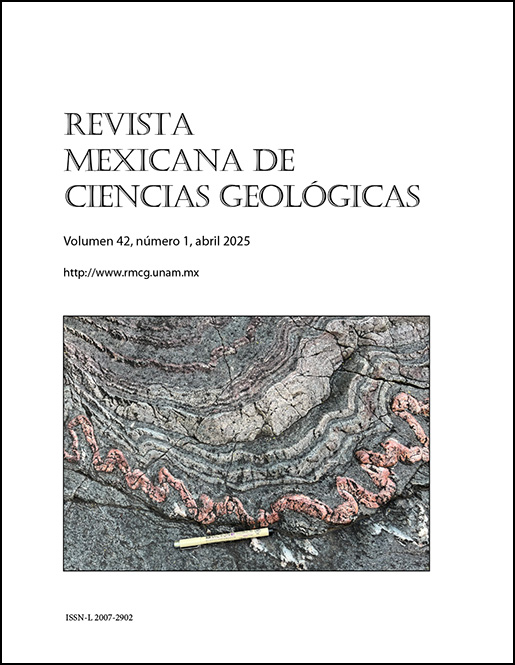Abstract
The main objective of this work is to investigate the influence of surface geological discontinuities on the hydraulic properties of the subsoil, studying an area affected by a fault (surface scarp) and a fracture (horizontal surface opening), which are separated by about 18 meters each other, forming part of a discontinuity system located within the Aguascalientes Valley (VA), Mexico. Both discontinuities are currently active due to the process of subsidence that the VA has been experiencing for more than 45 years, this emphasizes the relevance of this study since in most cases the studies are focused on regional inactive faults. In addition, studying some of the hydraulic properties of active discontinuities in the VA is significant because this valley currently has a large number of such structures with similar geologic conditions. As part of the methodology, 33-meter profiles of infiltration rates and hydraulic conductivity were obtained by applying permeability tests in the field, as well as 38-meter Electrical Resistance Tomography (ERT) profiles, in order to obtain and analyze the general characteristics of the subsoil and discontinuities. Subsequently, four ERT tests were applied in synchrony with punctual permeability test. The first ones in profiles of 14–17 meters, and the second ones in four points located at distances of under one meter from the discontinuities. These synchronized tests made it possible to visualize, in ERT profiles, the flow path of water injected into the subsurface through the permeameter, as well as the influence of the discontinuities on the hydraulic parameters mentioned above. The results show that the hydraulic parameters obtained in the areas close to the discontinuities, particularly the fault, are higher than those in the areas more distant from both discontinuities, probably due to their constant mechanical activity, being these increases of up to two orders of magnitude, obtaining maximum values of 2.08E-03 m/s for the infiltration velocity and 5.22E-05 m/s of hydraulic conductivity. On the other hand, observations from the simultaneous ERT-permeability tests suggest that discontinuities, particularly the fault, directly influence the path of infiltrated water, allowing the water to tend to move towards the displacement plane.
References
Aguascalientes, Gobierno del Estado (2022). Plan hídrico estatal 2021-2050 del estado de Aguascalientes: Periódico oficial del estado de Aguascalientes edición extraordinaria, july 19 2022. Aguascalientes, Gobierno del estado de Aguascalientes, Instituto del Agua del Estado, 218 pp.
Antonellini, M., & Aydin, A. (1994). Effect of Faulting on Fluid Flow in Porous Sandstones: Petrophysical Properties1. AAPG Bulletin, 78(3), 355–377. https://doi.org/10.1306/BDFF90AA-1718-11D7-8645000102C1865D
António, F., & Pacheco, L. (2002). Response to pumping of wells in sloping fault zone aquifers. Journal of Hydrology, 259(1), 116–135. https://doi.org/https://doi.org/10.1016/S0022-1694(01)00584-4
Aranda-Gómez, J. J., 1989, Geología preliminar del valle de Aguascalientes. Revista Mexicana de Ciencias Geológicas, 8(1), 22–32.
Ball, L. B., Ge, S., Caine, J.S., Revil, A., & Jardani, A. (2010). Constraining fault-zone hydrogeology through integrated hydrological and geoelectrical analysis. Hydrogeology Journal, 18(5), 1057–1067. https://doi.org/10.1007/s10040-010-0587-z
Balsamo, F., & Storti, F. (2010). Grain size and permeability evolution of soft-sediment extensional sub-seismic and seismic fault zones in high-porosity sediments from the Crotone basin, southern Apennines, Italy. Marine and Petroleum Geology, 27(4), 822–837. https://doi.org/https://doi.org/10.1016/j.marpetgeo.2009.10.016
Bense, V. F., & Person, M. A. (2006). Faults as conduit-barrier systems to fluid flow in siliciclastic sedimentary aquifers. Water Resources Research, 42(5), 1-18 https://doi.org/https://doi.org/10.1029/2005WR004480
Bense, V. F., Van den Berg, E. H., & Van Balen, R. T. (2003). Deformation mechanisms and hydraulic properties of fault zones in unconsolidated sediments; the Roer Valley Rift System, The Netherlands. Hydrogeology Journal, 11(3), 319–332. https://doi.org/10.1007/s10040-003-0262-8
Bense, V. F., Person, M. A., Chaudhary, K., You, Y., Cremer, N., & Simon, S. (2008). Thermal anomalies indicate preferential flow along faults in unconsolidated sedimentary aquifers. Geophysical Research Letters, 35(24), 1–6. https://doi.org/https://doi.org/10.1029/2008GL036017
Bense, V. F., Gleeson, T., Loveless, S. E., Bour, O., & Scibek, J. (2013). Fault zone hydrogeology. Earth-Science Reviews, 127, 171–192. https://doi.org/https://doi.org/10.1016/j.earscirev.2013.09.008
Bredehoeft, J. D., Belitz, K., & Sharp-Hansen, S. (1992). The hydrodynamics of the Big Horn Basin: a study of the role of faults. American Association of Petroleoum Geologists Bulletin, 76, 530–546.
Caine, J. S., & Forster, C. B. (1999). Fault zone architecture and fluid flow: Insights from field data and numerical modeling, in Haneberg, W.C., Mozley, P.S., Moore, J.C., and Goodwin, L.B., eds., Faults and sub-surface fluid flow in the shallow crust. American Geophysical Union Geophysical Monograph, 113, 101–127.
Caine, J. S., & Tomusiak, S. R. A. (2003). Brittle structures and their role in controlling porosity and permeability in a complex Precambrian crystalline-rock aquifer system in the Colorado Rocky Mountain front range. Geological Society of America Bulletin, 115(11), 1410–1424. https://doi.org/10.1130/B25088.1
Caine, J. S., Evans, J. P., & Forster, C. B. (1996). Fault zone architecture and permeability structure. Geology, 24(11), 1025. https://doi.org/10.1130/0091-7613(1996)024<1025:FZAAPS>2.3.CO;2
Cilona, A., Aydin, A., & Johnson, N.M. (2015). Permeability of a fault zone crosscutting a sequence of sandstones and shales and its influence on hydraulic head distribution in the Chatsworth Formation, California, USA. Hydrogeology Journal, 23(2), 405–419. https://doi.org/10.1007/s10040-014-1206-1
Constantin, J., Peyaud, J., Vergely, P., Pagel, M., & Cabrera, J. (2004). Evolution of the structural fault permeability in argillaceous rocks in a polyphased tectonic context. Physics and Chemistry of the Earth, Parts A/B/C, 29(1), 25–41. https://doi.org/10.1016/j.pce.2003.11.001
Constantz, J., Herkelrath, W. N., & Murphy, F., (1988). Air Encapsulation During Infiltration. Soil Science Society of America Journal, 52(1), 10–16. https://doi.org/https://doi.org/10.2136/sssaj1988.03615995005200010002x
Fronzi, D., Mirabella, F., Cardellini, C., Caliro, S., Palpacelli, S., Cambi, C., Valigi, D., & Tazioli, A., (2021). The Role of Faults in Groundwater Circulation before and after Seismic Events: Insights from Tracers, Water Isotopes and Geochemistry. Water, 13(11), 1–21.
Dynamic Monitors (2022). User Guide. ETC Pask (Constant Head well) permeameter for In-situ measurement of soil field saturated hydraulic conductivity. Engineering Technologies Canada Ltd & Dynamic monitors, 1–31.
Elrick, D. E., & Reynolds, W. D. (1986). An analysis of the percolation test based in three-dimensional saturated-unsaturated flow from a cylindrical test hole. Soil Science, 142(5). https://journals.lww.com/soilsci/fulltext/1986/11000/an_analysis_of_the_percolation_test_based_on.9.aspx
Evans, J. P., Forster, C. B., & Goddard, J. V., (1997). Permeability of fault-related rocks, and implications for hydraulic structure of fault zones. Journal of Structural Geology, 19(11), 1393–1404. https://doi.org/10.1016/S0191-8141(97)00057-6
Freeze, A. R., & Cherry, J. A. (1979). Groundwater. Prentice Hall Inc.
Gannon, J. P., Burbey, T. J., Bodnar, R. J., & Aylor, J. (2012). Geophysical and geochemical characterization of the groundwater system and the role of Chatham Fault in groundwater movement at the Coles Hill uranium deposit, Virginia, USA. Hydrogeology Journal, 20(1), 45–60. https://doi.org/10.1007/s10040-011-0798-y
González-Cervantes, N., Aranda-Gómez, J. J., Carranza-Castañeda, O., & Ortega-Obregón, C. (2019). Edad y origen de la paleocuenca continental de Teocaltiche, México. Revista Mexicana de Ciencias Geológicas, 36(3), 393–410. https://doi.org/10.22201/cgeo.20072902e.2019.3.1391
Helena, P., Houben, G., & Himmelsbach, T. (2016). Numerical modeling of fracking fluid migration through fault zones and fractures in the North German Basin. Hydrogeology Journal, 24. https://doi.org/10.1007/s10040-016-1418-7
Hernández-Marín, M., González-Cervantes, N., Pacheco-Martínez, J., & Frías-Guzmán, D. H. (2015). Discussion on the origin of surface failures in the Valley of Aguascalientes, México. Proceedings of the International Association of Hydrological Sciences, 372. https://doi.org/10.5194/piahs-372-235-2015.
Hernández-Marín, M., Pacheco-Martínez, J., Burbey, T. J., Carreón-Freyre, D. C., Ochoa-González, G. H., Campos-Moreno, G. E., & de Lira-Gómez, P. (2017). Evaluation of subsurface infiltration and displacement in a subsidence-reactivated normal fault in the Aguascalientes Valley, Mexico. Environmental Earth Sciences, 76(24), 1–12. https://doi.org/10.1007/s12665-017-7163-y.
Hernández-Marín, M.; Guerrero-Martínez, L.; Zermeño-Villalobos, A.; Rodríguez-González, L.; Burbey, T. J.; Pacheco-Martínez, J.; Martínez-Martínez, S. I.; & González-Cervantes, N. (2018). Spatial and Temporal Variation of Natural Recharge in the Semi-Arid Valley of Aguascalientes, Mexico. Hydrogeology Journal, 26, 2811–2826. https://doi.org/10.1007/s10040-018-1819-x.
Heynekamp, M. R., Goodwin, L. B., Mozley, P. S., & Haneberg, W. C. (1999), Controls on fault zone architecture in poorly lithified sediments, Rio Grande Rift, New Mexico: implications for fault-zone permeability and fluid flow. In W. C., Haneberg, P. S., Mozley, J., Casey Moore, & L. B. Goodwin (Eds.), Faults and Subsurface Fluid Flow in the Shallow Crust. AGU Geophysical Monograph, 113, 27–51.
Lee, C. F., Zhang, J. M., & Zhang, Y. X. (1993). Evolution and origin of the ground fissures in Xian, China. Engineering Geology, 43(1), 45–55.
Loza-Aguirre, I., Nieto-Samaniego, A. F., Alaniz-Alvarez, S. A., & Iriondo, A. (2008). Relaciones estratigráfico-estructurales en la intersección del sistema de fallas San Luis-Tepehuanes y el graben de Aguascalientes, México Central: Revista Mexicana de Ciencias Geológicas, 25(3), 533-548.
Martin, R. V, Van Arsdale, R. B., & Harrison, V. J. (2023). Possible Fault Communication between the Memphis Sand Aquifer and the Mississippi River. Environmental & Engineering Geoscience, 29(2), 105–114. https://doi.org/10.2113/EEG-D-22-00050
Nieto-Samaniego, A. F., Alaniz-Álvarez, S. A., & Camprubí, A. (2005). Mesa Central of México: Stratigraphy, structure, and Cenozoic tectonic evolution. Boletín de la Sociedad Geológica Mexicana. 57(3), 285-318.
Nieto-Samaniego, A. F., Del Pilar-Martínez, A., Suárez-Arias, A. M., Angeles-Moreno, E., Alaniz-Álvarez, S. A., Levresse, G., Xu, S., Olmos-Moya, M. J. P., & Báez-López J. A. (2023). Una revisión de la geología y evolución tectónica cenozoicas de la Mesa Central de México. Revista Mexicana de Ciencias Geológicas, 40(2), 187-213. https://doi.org/10.22201/cgeo.20072902e.2023.2.1736.
Ochoa-González, G. H., Carreón-Freyre, D., Cerca, M., & López-Martínez, M (2015). Assessment of groundwater flow in volcanic faulted areas. A study case in Queretaro, Mexico. Geofísica Internacional, 54(3). https://doi.org/10.1016/j.gi.2015.04.016
Pacheco-Martínez, J., Hernandez-Marín, M., Burbey, T. J., González-Cervantes, N., Ortíz-Lozano, J. T., Zermeño-De-Leon, M. E., & Solís-Pinto, A. (2013). Land subsidence and ground failure associated to groundwater exploitation in the Aguascalientes Valley, México. Engineering Geology, 164. https://doi.org/10.1016/j.enggeo.2013.06.015
Petrie, E. S., Petrie, R. A., & Evans, J. P. (2014). Identification of reactivation and increased permeability associated with a fault damage zone using a multidisciplinary approach. Journal of Structural Geology, 59, 37–49. https://doi.org/https://doi.org/10.1016/j.jsg.2013.11.008
Reyes-Cedeño, I. G., Hernández-Marín, M., Pacheco-Guerrero, A. I., & Gannon, J. P. (2023). Application of Vertical Electrical Sounding and Toxicity Tests for the Analysis of Vertical Hydraulic Connectivity through the Vadose Zone. Water, 16(2), 1–20.
Reynolds, W. D. (1993). Saturated hydraulic conductivity: field measurement. En Carter M.R. (Ed.), Soil Sampling and Methods of Analysis (pp. 599–613).
Rugh, D. F., & Burbey, T. J., (2008), Using saline tracers to evaluate preferential recharge in fractured rocks, Floyd County, Virginia, USA. Hydrogeology Journal, 16(2), 251–262. https://doi.org/10.1007/s10040-007-0236-3
Seaton, W. J., & Burbey, T. J. (2005) Influence of ancient thrust faults on the hydrogeology of the blue ridge province. Groundwater, 43(3), 301–313. https://doi.org/https://doi.org/10.1111/j.1745-6584.2005.0026.x
Servicio Geológico Mexicano (1998). Carta geológico-minera Aguascalientes F13-9. Servicio Geológico Mexicano, 1 map.
Stoessell, R. K., & Prochaska, L. (2005). Chemical Evidence for Migration of Deep Formation Fluids into Shallow Aquifers in South Louisiana. Gulf Coast Association of Geological Societies Transactions, 55, 794–808.
Streeter, V., & Wylie, E. B., (1975), Fluid Mechanics (6ta ed.). McGraw Hill.

This work is licensed under a Creative Commons Attribution 4.0 International License.
Copyright (c) 2025 Martín Hernández-Marín, Norma González-Cervantes, Lilia Guerrero-Martinez, Christian Emmanuel Rodríguez-Padilla, Jesús Pacheco-Martínez












